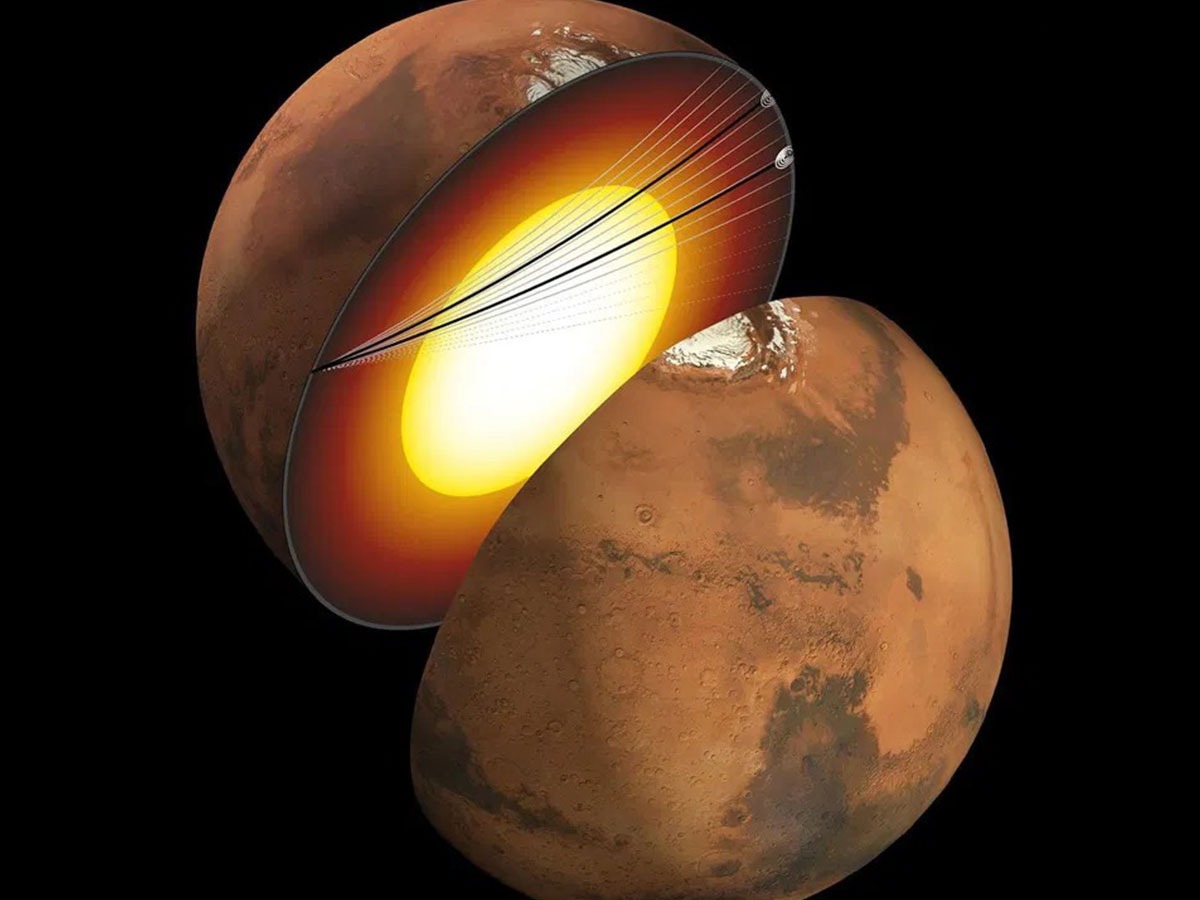
Underground Water Reserves on Mars Could Form Oceans, According to New Study
Scientists have discovered evidence of a large underground water reservoir deep beneath the surface of Mars, using data from a retired NASA mission. This water, trapped in tiny cracks and pores of rock within Mars’ crust, could potentially be enough to fill oceans on the planet’s surface. The study, published in the journal Proceedings of the National Academy of Sciences, suggests that if this water were spread across Mars, it would cover the planet to a depth of about 1 mile (1.6 kilometers).
The data leading to this discovery was collected by NASA’s InSight lander, which operated from 2018 to 2022. The InSight mission focused on studying the interior of Mars, using a seismometer to detect and analyze “marsquakes.” These quakes helped scientists understand the composition and structure of the Martian crust, mantle, and core. One of the key findings from InSight’s data is the possible existence of a deep reservoir of liquid water.

Accessing this water would be extremely challenging for future astronauts. The water is located deep underground, between 7 and 12 miles (11.5 and 20 kilometers) beneath the Martian surface. This depth makes it difficult to reach, requiring advanced technology and significant resources.
The discovery of this underground water also opens up new possibilities in the search for life on Mars. If life ever existed on Mars, or still does, this deep reservoir could be a potential habitat. On Earth, life can be found deep underground, in environments similar to what might exist in Mars’ mid-crust.
Understanding the water cycle on Mars is crucial for learning more about the planet’s history and its potential to support life. Mars was likely much warmer and wetter billions of years ago, with evidence of ancient lakes, rivers, and deltas. However, the planet lost its atmosphere over 3 billion years ago, leading to a dramatic change in its climate and the drying up of its surface water.
Scientists are still trying to understand exactly what happened to Mars’ water after it lost its atmosphere. Some theories suggest that the water became ice, was lost to space, or was absorbed into minerals within the planet’s crust. The new findings suggest that much of this water may have filtered deep into the Martian crust, forming the reservoir now detected by the InSight mission.
InSight’s seismometer detected more than 1,300 marsquakes during its mission. Unlike earthquakes on Earth, which are caused by the movement of tectonic plates, marsquakes occur due to the cooling and shrinking of the planet’s crust. As the crust stretches and cracks, these quakes send seismic waves through Mars, which can be analyzed to determine the composition of the planet’s interior.
The speed at which these seismic waves travel depends on the materials they pass through. By studying these waves, scientists can infer what kinds of rocks are present and whether those rocks contain water. InSight’s data suggests that there is a layer of igneous rock, or volcanic rock, deep beneath the surface, and this rock is likely filled with liquid water.
This discovery provides valuable insights into Mars’ climate, both past and present. Water is a key element for life, and the presence of liquid water underground raises questions about whether these deep environments could be habitable. On Earth, similar deep underground environments host a wide variety of life forms, including microbes that thrive in extreme conditions.
If Mars’ crust is similar across the planet, this mid-crust zone could contain more water than what is believed to have filled the hypothesized ancient oceans of Mars. This would mean that a significant portion of Mars’ water might still be present underground, rather than having been lost to space or locked away as ice at the poles.

While this analysis can’t directly tell us if life ever existed on Mars, it does suggest that the Martian crust could be a place where life could survive, much like certain deep underground habitats on Earth. However, drilling to such depths on Mars would be a massive undertaking. Even on Earth, drilling deep underground is a complex and energy-intensive task. On Mars, it would require a significant amount of resources and advanced technology to reach the water reservoir.
Interestingly, scientists did not find evidence of frozen groundwater at shallower depths above the mid-crust, which was surprising given the cold temperatures of that part of the crust. The research team is still working to understand why this might be the case.
The discovery of this deep underground water adds a new piece to the puzzle of Mars’ water history. For decades, scientists have speculated about the existence of liquid water deep beneath Mars’ surface. Now, for the first time, real data from a Mars mission supports this idea.
Alberto Fairén, a planetary scientist and astrobiologist at Cornell University, who was not involved in the study, noted that this water is likely more like deep underground mud rather than large lakes. However, the existence of liquid water-saturated sediments, or aquifers, is still a significant finding. On Earth, the underground biosphere is vast and contains much of our planet’s microbial diversity. Some researchers even believe that life on Earth may have originated deep underground. This makes the discovery of liquid water on Mars extremely exciting for those studying the possibility of life on other planets.
Bruce Banerdt, the principal investigator for the InSight mission, expressed that this kind of discovery is exactly what he hoped the mission would achieve. While the interpretation of the data is strongly supported by the research, Banerdt acknowledges that there may be other explanations for the findings. Nonetheless, the discovery opens up new avenues for exploring Mars’ history, climate, and potential for life.
Both Banerdt and lead study author Vashan Wright believe that more seismometers should be sent to Mars and other planets in our solar system. While InSight’s single seismometer provided valuable data, spreading out multiple seismometers across Mars could offer a more detailed view of the planet’s interior and its diverse geological history.
The groundwater detected on Mars today is likely a remnant of the planet’s wetter past, and understanding it could help us learn more about Mars’ climate and the possibility of life on the Red Planet.





